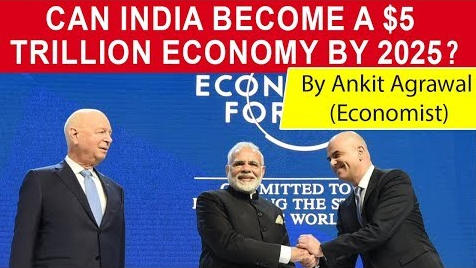Table of Contents

Q) Which among the following is the most appropriate definition of Gross Domestic Product?
- A)- GDP is the monetary value of all the finished goods and services produced by the country irrespective of their location.
- B)- GDP is the monetary value of all the finished goods and services produced by the country irrespective of their location that is adjusted to account for depreciation.
- C)- GDP is the final value of the goods and services produced within the geographic boundaries of a country that is adjusted to account for depreciation.
- D)- GDP is the final value of the goods and services produced within the geographic boundaries of a country.
WHAT DOES $5 TRILLION ECONOMY MEAN?
- At ₹70 per U.S. dollar exchange rate
- It is ₹350,00,000 crore of gross domestic product (GDP) at current prices.
- At present India is a $2.7 trillion economy
- That means ₹190,10,164 crore of GDP at current prices.
- The annual per capita income is ₹1,42,719 or about ₹11,900 per month.
WHERE INDIA STAND AS OF NOW?

- According to World Bank data, India became the world’s sixth largest economy in 2017 surpassing France.
- 3rd by purchasing power parity (PPP).
- 139th in per capita GDP (nominal)



WHAT WILL TAKE US TO $5 TRILLION?
- An output expansion by 84% in five years.
- In other words 13% compound annual growth rate.
- Taking 4% inflation into consideration, the required growth rate in real terms is 9% per year.
WHAT SHOULD BE DONE TO ACHIEVE $5 TRILLION ECONOMY?
- Mobilizing domestic saving and raising fixed investment rates are the key.
- 39% of domestic savings rate.
- 41.2% of investment rate.
- In the last 5 years, on average, the domestic saving rate was 30.8% and the investment rate was 32.5%.

- The Incremental Capital Output Ratio (ICOR) must decrease with advancement in technology.

- It is the relationship between the level of investment made in the economy and the consequent increase in GDP.
Foreign capital inflow must increase to further boost the Investment.
- It includes
- FDI- Foreign Direct investment
- FPI- Foreign Portfolio investment
- ECB- External commercial borrowings.
- NRI deposits- Non-resident Indians.

WHAT ECONOMIC SURVEY SAYS ON $5 TRILLION ECONOMY?
- Growth of 8% can only be sustained by a “virtuous cycle” of savings, investment and exports catalyzed and supported by a favourable demographic phase.
- Investment, especially private investment, is the “key driver” that drives demand, creates capacity, increases labour productivity, introduces new technology, allows creative destruction, and generates jobs.
- Exports must form an integral part of the growth model because higher savings preclude domestic consumption as the driver of final demand.
PAST RECORDS OF OTHER ASIAN COUNTRIES
- China’s growth record of best five years was during 2003-07, grew at 11.7%.
- South Korea, between 1983 and 1987, grew at 11%.
- Thus the target is smaller than the best historical records and may seem realistic.
- But the current scenario gives a stark picture
- India officially grew at 7.1% over the last five years and the annual growth rate never touched 9%.
- Domestic saving rate has declined from 31.4% in 2013-14 to 29.6% in 2016-17.
- Investment rate from 33.8% to 30.6% during the same period.
- FDI inflow is at 1.5% of GDP in 2017-18 while it peaked in 2008-09 at 2.7% of GDP.
Q) Which among the following is the most appropriate definition of Gross Domestic Product?
- A)- GDP is the monetary value of all the finished goods and services produced by the country irrespective of their location.
- B)- GDP is the monetary value of all the finished goods and services produced by the country irrespective of their location that is adjusted to account for depreciation.
- C)- GDP is the final value of the goods and services produced within the geographic boundaries of a country that is adjusted to account for depreciation.
- D)- GDP is the final value of the goods and services produced within the geographic boundaries of a country.
Latest Burning Issues | Free PDF






















 WhatsApp
WhatsApp